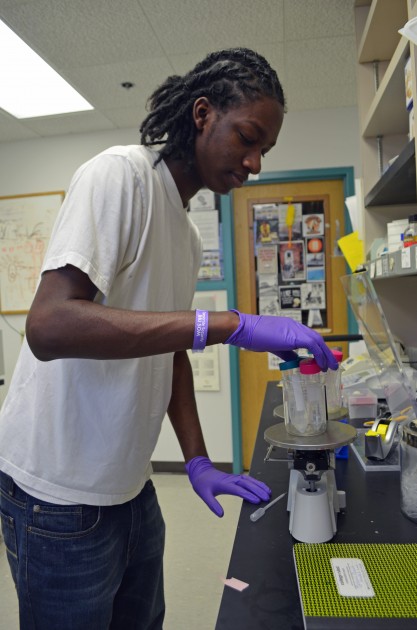Tyren Day, an 18-year-old who grew up in West Baltimore, once figured he'd become a tradesman, probably a mason. But after spending last summer purifying cells and cloning genes in a Johns Hopkins University biophysics lab, he says his plans have changed. Heís thinking scientist, researcher, maybe even doctor.

Image caption: Tyren Day, 18, works in a Johns Hopkins University lab as part of the Biophysics Research for Baltimore Teens summer program.
"It got me to see things in a different light," says Day, who's now majoring in chemistry at Community College of Baltimore County and has returned to Johns Hopkins this summer. "Where I come from, itís hard. Just going to college is awesome. But now I know I can go to med school. I could go to graduate school. I just want to learn more."
Day is part of Biophysics Research for Baltimore Teens, a paid summer internship program that aims to give high school students from low-income communities a head start in science careers by exposing them to university-level biomedical lab work.
"In the lab, they actually witness the cutting-edge discovery process," says Jungsan Sohn, the program's director and an assistant professor of biophysics and biophysical chemistry in the Johns Hopkins School of Medicine. "At the end of the summer, I hope they understand that science is cool. And that by learning science, they have the possibility to do whatever they want."
This summer's four interns started June 17 and will continue, five days a week, through Aug. 16. They are spending their days taking classes in the fundamentals of science and conducting basic research in labs on the Homewood and East Baltimore campuses. Each intern is paired with a faculty, lab, and undergraduate mentor, all available to help with classwork and talk about possible career paths.
After a summer of microscopes and test tubes, the interns will present their research to faculty, postdocs, and graduate students in September at the annual retreat of the university's Institute for Biophysical Research.
Bertrand Garcia-Moreno, chairman of the Thomas C. Jenkins Department of Biophysics in the universityís Krieger School of Arts and Sciences, says he watched one internís confidence grow last summer as he and others in the lab showed the student how to modify proteinsflthe same work happening at more advanced levels in the biotech industry.
"When high school students come in, they're like deer in the headlights," Garcia-Moreno says. "But I hope they come out with the assurance that they can do anything and with an awareness about a whole world they could never before imagine."
Biophysics Research for Baltimore Teens is an offshoot of a similar program called Medical Education Resources Initiative for Teens, which was launched in 2011 by two former city teachers. Through that yearlong program, high school sophomores in city schools who have the potential but perhaps not the means to attend medical school get a leg up with SAT tutoring, college admissions help, and summer internships at Johns Hopkins Bayview Medical Center and the National Institute of Drug Abuse.
Funding for Biophysics Research for Baltimore Teens comes from Johns Hopkins' Office of the Provost, School of Medicine Dean's Office, Office of Multicultural Affairs, and Thomas C. Jenkins Department of Biophysics; and Baltimore City YouthWorks.
This summer, Day is learning how DNA proteins move along the DNA chain in the lab of James T. Stivers, a pharmacology and molecular sciences professor in the School of Medicine. "As long as you're engaged and learning, they are with you," Day says about being on campus. "They donít care about before; they want you to know what's in the future."







